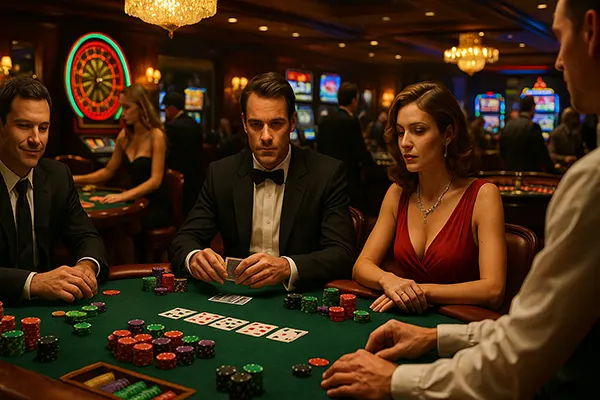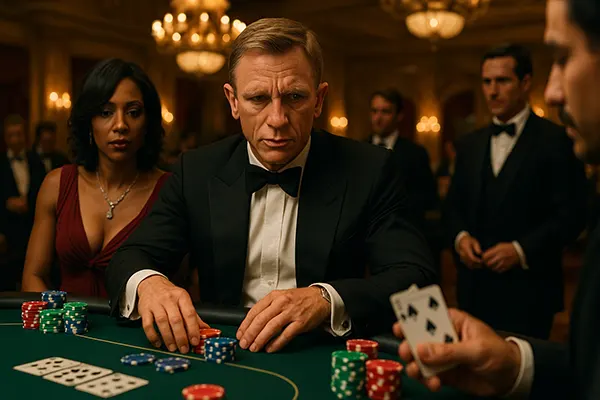
Gambling in Films: Real Casinos and Games That Appeared in Iconic Movies
Gambling has been a recurring motif in cinema, embodying thrill, risk, and psychological intrigue. Across decades, filmmakers have used real-world casinos and authentic games to heighten realism and deepen narrative immersion. As of June 2025, several of these cinematic choices continue to be celebrated by fans and critics alike for their cultural and historical resonance.
Famous Casinos on the Big Screen
Real-life casinos have often become cinematic landmarks, lending authenticity to gambling scenes. One of the most iconic examples is the Bellagio in Las Vegas, prominently featured in “Ocean’s Eleven” (2001). Its luxurious interior and fountain-laden exterior provided a fitting backdrop for the high-stakes heist central to the film’s plot.
Another memorable appearance is the Riviera, which played a crucial role in Martin Scorsese’s “Casino” (1995). Though demolished in 2016, its legacy lives on through the film’s depiction of the mob’s influence in Las Vegas’ gaming industry. The scenes shot there captured the opulence and tension of the era.
Monte Carlo Casino in Monaco remains an enduring symbol of sophistication, appearing in multiple James Bond films, including “GoldenEye” (1995) and “Casino Royale” (2006). Its association with Bond reinforces the global image of elegance and espionage intertwined with gambling.
Las Vegas as a Cinematic Character
More than a setting, Las Vegas often acts as a character in its own right. In “The Hangover” (2009), the city’s unpredictable nature underscores the chaotic narrative, where memory loss and outrageous adventures are spurred by a wild night in Vegas. The film features several real locations, including Caesars Palace.
“21” (2008), based on the true story of MIT students who used card-counting techniques to beat blackjack, used Planet Hollywood and Red Rock Casino for many scenes. These real casinos enhanced the film’s dramatic depiction of risk and calculation.
Even lesser-known films like “Lucky You” (2007) capture the Las Vegas poker circuit’s nuances. The use of actual venues added a layer of credibility that resonated with serious players and casual viewers alike.
Real Gambling Games in Iconic Scenes
Movies often portray authentic games not just for aesthetics, but to reflect real strategies and outcomes. Poker, especially Texas Hold’em, is perhaps the most represented, particularly in “Rounders” (1998). The film realistically portrays underground poker scenes and player psychology, helping fuel the poker boom of the 2000s.
“Casino Royale” (2006) features a pivotal Texas Hold’em match between James Bond and villain Le Chiffre. The scenes were notable for their realistic tension and strategic depth, albeit slightly stylised for dramatic effect. Experts praised the accurate presentation of game mechanics.
“The Cincinnati Kid” (1965) focuses on Five-card Stud, a less common game today but historically significant. The final showdown is celebrated for its emotional impact and representation of old-school gambling culture, reflecting genuine card dynamics and human drama.
Blackjack, Roulette and More
Blackjack has frequently appeared in film due to its simplicity and strategic depth. “Rain Man” (1988) features perhaps the most famous example, where card counting enables the protagonists to win big in Caesars Palace. This scene introduced many to the mathematics behind the game.
Roulette, with its iconic spinning wheel, often symbolises fate. In “Run Lola Run” (1998), a single spin represents life-or-death stakes. The game’s use here is metaphorical, yet grounded in real probability principles. “Indecent Proposal” (1993) also uses roulette as a turning point in the narrative.
In more recent years, baccarat has seen resurgence, notably in “Skyfall” (2012), reintroducing the game to a younger audience. Though simplified for pacing, these depictions accurately reflect betting options and gameplay structure.

The Cultural Impact of Casino Depictions
Films that showcase real gambling environments influence public perception of the industry. “Casino” (1995), for example, shed light on historical ties between organised crime and gaming operations. Its realism and historical context continue to inform public discourse around regulatory changes and integrity in gambling.
On a different note, the glamorisation of casino culture in films like “Ocean’s Eleven” and James Bond series has contributed to romanticised views of gambling. The balance between cinematic allure and real-life risk remains a point of cultural discussion, especially in educational and regulatory contexts.
Moreover, films often spark interest in specific games. Following “Rounders,” the interest in Texas Hold’em surged globally, culminating in increased tournament participation and online game traffic. Movies can thus act as informal educators on rules, strategy, and psychology.
Global Locations Beyond Las Vegas
While Las Vegas remains dominant, international venues have gained prominence through cinema. Monte Carlo’s role in Bond films helped position European casinos as cultural icons, not just gambling hubs. The casino in “Dr. No” (1962) also introduced Jamaica’s gambling culture to global audiences.
Asian gambling centres like Macau were featured in “Skyfall” (2012), reflecting the region’s growth in global gambling relevance. The scene set in the floating casino in Macau showcased real design elements and cultural context specific to the area’s gaming industry.
In Indian cinema, films like “Teen Patti” (2010) and “Jannat” (2008) explore gambling from different societal angles, often highlighting moral conflicts and legal dilemmas. These representations contribute to a wider cultural dialogue about regulation and risk.
